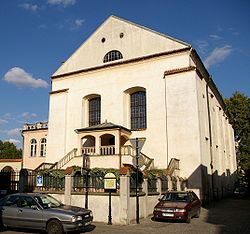
Izaak Synagogue
Encyclopedia

Kazimierz
Kazimierz is a historical district of Kraków , best known for being home to a Jewish community from the 14th century until the Second World War.-Early history:...
District of Kraków
Kraków
Kraków also Krakow, or Cracow , is the second largest and one of the oldest cities in Poland. Situated on the Vistula River in the Lesser Poland region, the city dates back to the 7th century. Kraków has traditionally been one of the leading centres of Polish academic, cultural, and artistic life...
, Poland
Poland
Poland , officially the Republic of Poland , is a country in Central Europe bordered by Germany to the west; the Czech Republic and Slovakia to the south; Ukraine, Belarus and Lithuania to the east; and the Baltic Sea and Kaliningrad Oblast, a Russian exclave, to the north...
. The synagogue is named for its donor, Izaak Jakubowicz (d. 1673), also called Isaac the Rich, a banker to King Władysław IV. The synagogue was designed by Francesco Olivierri, an Italian working in Poland in that era. Jakubowicz is buried in the Remuh Cemetery
Remuh Cemetery
The Remuh Cemetery, also known as the old Jewish cemetery of Kraków , in Kraków, Poland, is a Jewish cemetery established in 1535. It is located beside the Remuh Synagogue at 40 Szeroka Street in the historic Kazimierz district of Kraków....
. Variants of the name include Ayzik , Izaak, and Isaac. Izaak is the standard Polish spelling, while Jakubowicz is Polish for a "Son of Jacob."
Legend associated with this synagogue
"The founder of the synagogue is the hero of a well-known legend deriving from the Tales of 1001 Nights. Ayzik Jakubowicz, a pious but poor Jew, dreamed that there was treasure hidden under the old bridge in Prague. Without delay, he made his way there. On arrival, it turned out the bridge was guarded by a squad of soldiers and that digging was out of the question. Ayzik told the officer about his dream, promising him half of the booty. The officer retorted, "Only fools like Polish Jews can possibly believe in dreams. For several nights now I have been dreaming that in the Jewish town of Kazimierz there is hidden treasure in the oven of the home of the poor Jew Ayzik Jakubowicz. Do you think I am so stupid as to go all the way to Cracow and look for the house of this Isaac the son of Jacob?". Ayzik returned home immediately, took the oven apart, found the treasure and became rich. After this it was said: 'There are some things which you can look for the world over, only to find them in your own home. Before you realise this, however, you very often have to go on along journey and search far and wide.' "Architecture
The interior walls of the early Baroque building are embellished with painted prayers, visible after conservation removed covering layers of paint. The vaulted ceiling is embellished with baroque plasterwork wreaths and garlands. Before the Nazi occupation of Poland, the synagogue boasted a widely-admired, wooden, baroque Aron Kodesh. When the building was planned, the design was considered by some diocesan officials to be too beautiful for Jews to have, which led to delays in the synagogue’s construction. Architectural historian Carol Herselle KrinskyCarol Herselle Krinsky
Carol Herselle Krinsky Architectural historian, born in New York City, New York, USA. She studied at Smith College New York University, Krinsky is a professor of twentieth-century architectural history at New York University...
considers the Isaak (Isaac) to be "the most architecturally important" of all the old synagogues of Krakow. According to Krinsky, the womes's gallery and exterior stairs leading to it are a later addition to the building.
History
On 5 December 1939, the Gestapo came to the Krakow JudenratJudenrat
Judenräte were administrative bodies during the Second World War that the Germans required Jews to form in the German occupied territory of Poland, and later in the occupied territories of the Soviet Union It is the overall term for the enforcement bodies established by the Nazi occupiers to...
building and ordered, Maximilian Redlich, the Jewish official on duty that day to burn the scrolls of the Torah. When Redlich refused he was shot dead.
Nazis destroyed the interior and furnishings, including the bimah and Aron Kodesh. After the war, the building was used by a sculpture and conservation atelier and then by a theatre company as workshop space and for the storage of props. A fire in 1981 damaged the interior. A renovation was begun in 1983 and in 1989, with the fall of communism in Poland, the building was returned to the Jewish community. It is presently used as an exhibition space.

